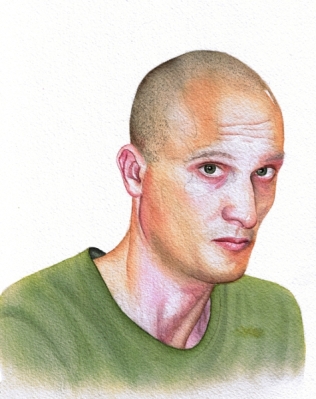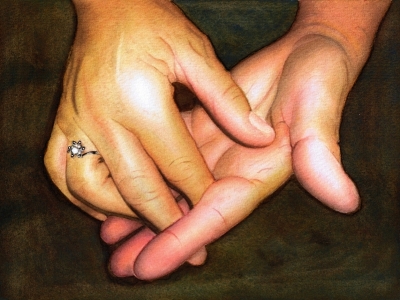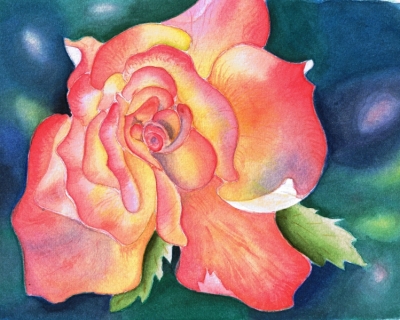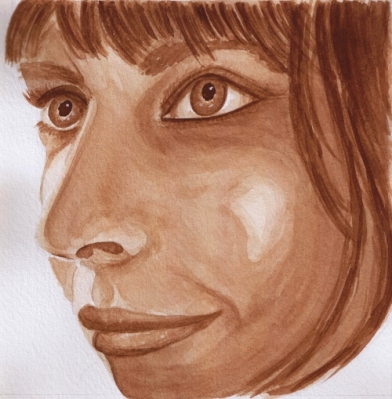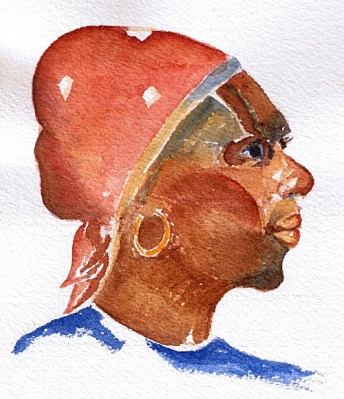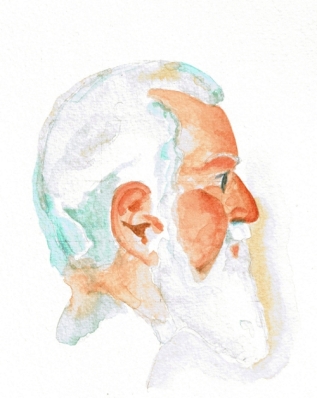Posts Tagged: painting
Tim, color study
I am painting again, or trying to… After my 5 months graphite marathon, a.k.a. The Sketchbook Project, I forgot how to paint. This is my second watercolor study of Tim (click the link to see the graphite portrait of him). The first painting study of him was a disaster and I am not posting it. But it is all good and valuable, I am slowly remembering how to handle glazes, a little dry brush, handling and mixing colors. It goes very slowly, I feel as if I am struggling with my hues and values, forcing the media to do what I see in my mind’s eye. This is very different from the free and fluid feeling I had with graphite. By the end of the Sketchbook Project I was simply using the media to render what I wanted, not trying to subdue it into compliance. But I now know about practice, diligence and patience, and what results can be achieved with that. This after all is only the first of a new series I have in mind.
7″x9″ (18 x 23 cm) watercolor on paper
For being alive – in color
For being alive is now complete in watercolor. I am somewhat disappointed with the end result – I did not succeed in creating a sense of aliveness to the extent I imagined and planned. But I learned a lot in the process, so I am calling it a study. It is done in limited palette (pyrrol red, red oxide, ultramarine, cobalt blue, new gamboge and sepia). During a critique session in class I realized that my composition crop is working against the image, my background is not strong enough to bring forth my idea, and skin colors lost their variety of blues and violets somewhere in the process. On a positive side I am pleased with the 3D effect I was able to achieve, her expression and the lines of her body.
10″ x 14″ (25 x 36 cm) watercolor on paper
To love and to hold
In my mind this painting of hands is a portrait, so I am putting it up with a “portrait” tag. Hands are often as expressive as faces, and sometimes even more so. While working on this painting I realized that I love painting hands and will be doing more of that.
For people who are interested in technique, this is done in glazing method and limited palette, although I used a different palette for each of the hands. As I was planning the painting and making color swatches, I couldn’t come up with a set of primary pigments that would give me the tones on both hands. Of course I ran to my teacher with my difficulty, and she pointed out that the hands have a different color temperature in the reference – one is cool and one is warm. And suddenly it made perfect sense: I used a warm primaries for the top hand and cool primaries for the bottom one. And in the end I married the two by bringing the warms to the cool hand and cools to the warm one, but in small areas, to unify them.
6.5″ x 8.5″ (16 x 22 cm) watercolor on paper
Sly III
I finished my final version of Sly. See the graphite drawing of her and the monochromatic version in the previous posts. This one was done using a limited palette of 4 colors – cadmium red, cadmium yellow, ultramarine blue and sepia. My teacher thinks I have a natural aptitude for glazing technique and had me do this portrait by painting about 50 thousand glazes of mostly water.
6″ x 6″ (15 x 15 cm) watercolor on paper
Psychedelic flower – Take 2
Another take on a pink rose, or Psychedelic flower, as my friend Sam Harrison aptly named it. This time the painting is on Ampersand Aquabord Museum Series Panel, a new painting surface I’ve been trying. Now that the painting is finished I can say that Aquabord with its pebbly clay surface will very likely become my support of choice.
Aquabord takes watercolor like nothing else I tried. It doesn’t bend or buckle, does not need stretching or post-painting straightening. The clay allows for gazillion washes, clearly shows where it is wet so you can’t skip a spot when painting with water, dries to brilliant white or color, and allows lifting and changes of mind with no difficulty. It behaves very much like a Cold Press paper less qualities that I don’t like. It is archival, acid-free and non-yellowing. I understand that it is possible to spray/fix a painting on Aquabord with Krylon finishing spray and frame it without glass. Even better – Ampersand makes Aquabord in a form of a cradle, so work can be displayed without a frame altogether provided sides are finished professionally.
To be objective there were two things I liked less than others. One was that when I wet the clay surface before applying a wash it darkens like wet sand, which makes it somewhat of a guess game what the resulting color will be when it dries. But I soon learned to guess with a great degree of accuracy. And two – it takes more pigment. More pigment than paper that is, but not as much for me to go broke buying more. With this said, in my mind there are not enough negatives to overcome the positives of this beautiful surface. And – No, I do not work for Ampersand!
8″x10″ (20×25 cm) watercolor on Aquabord
Washing a flower
I have been practicing washes in watercolor. I drew a generic flower freehand, so I didn’t have to be concerned with things like anatomical correctness, likeness or too much perspective. The idea was to make two or three washes of different hues meet with a smooth transition at a line or curve of my choosing. Each petal as an individual pool of washes.
I couldn’t do it. My washes were all over the place. I can do a single wash and control it enough for it to end where and how I want. Then when it is dry I can put a second wash of a different hue over it or next to it and control it enough to do the transition. But not two wet washes simultaneously. More practice is needed.
My painting teacher liked this little watercolor, a dear heart that she is, and encouraged me to finish it. I am glad I did because in the process I learned how to deepen my hues with Sepia. Here it is. I am off to practice more washes.
7” x 9” (18 x 24 cm) watercolor on paper
Sly – monochromatic
The same face I worked in graphite a few days ago – Sly – now in watercolor, a monochromatic study in preparation for painting a full color portrait. I find her face and expression rather out of the ordinary and complex. Interestingly I have heard quite diverse takes on her expression – sly, crafty, furtive, beautiful, b!tch, bored, boring, playful, coy, cunning, just to name a few. It is very rewarding to me to take in all these different reactions, perhaps it means that I produced a portrait complex and unorthodox enough to cause them.
6″ x 6″ (15 x 15 cm), Burnt Umber on Fabriano Soft Press.
She wears a red bandana
Second quick watercolor sketch from Charles Reid book. This one was harder because first I got in trouble with my drawing and had to start over. Then my pigments wouldn’t give me as dark of a mark as I wanted. So I went over some areas again to build value and it shows.
Another new happening for me – for this sketch I dispensed with my porcelain palette and its individual wells and used a white dinner plate instead. I made dabs of strong pigment and let them mix mud-pie style on my plate. It was great! When I needed sienna-umber 50-50 mix I would pick it up from the middle between the dabs. When I wanted my mix to be more red I moved closer to the center of burnt sienna dab. When I wanted my color tinted I would pull some ultramarine in the center. Very convenient – all color and value gradations where right there on my dinner plate. It took 2 hours to paint her, but it would probably take much longer if I would mixed my colors in the wells each one separate from the other.
5” x 4” (13 x 10 cm) on Arches Cold Press, Cotman pan paints
Saint Nick?
Well, no. I am sure he is not, because he is an exercise from Charles Reid’s book Watercolor Solutions. But he definitely makes me think of St. Nicolas. Must be the beard. I am obsessed with white beards these days because a salt-and-pepper beard from a graphite portrait I am working on is eluding me.
What is astonishing about this sketch is the fact that I painted him in one hour. Including the drawing. Perhaps I do have a little predisposition for portrait after all – an amazing thought! Which is not a thing to say about my painting of water (not shown here because it turned out a disaster.) Or perhaps it is Charles Reid’s technique – 3 super-saturated colors, wet-on-dry, almost dry brush but not quite, no waiting and no smoothing of edges, stop before you think you are finished.
I used my new Escoda 1212 Tajmir Kolinsky brushes, a Hanukkah gift from my parents. Even though I am an adult of respectable age, my dear parents still give me Hanukkah gifts – how wonderful! Well, I painted with them for the first time, and I am here to say: Escoda Kolinsky are a pure bliss!
5” x 6” (13 x 16 cm) on Cotman Watercolor pad, Cotman pan colors.

